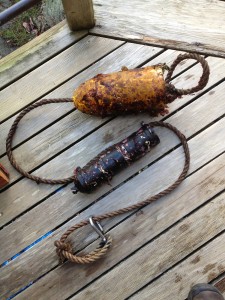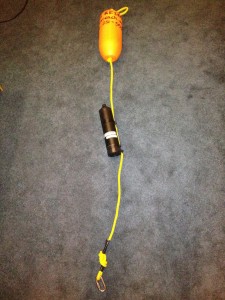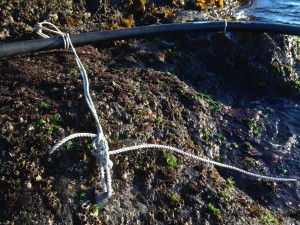Salmon detector replaced at Orcasound
Another Vemco fish tag receiver was replaced today, helping prepare for another season of tracking blackmouth (resident Chinook salmon) in the San Juan Islands. This wintertime field work is part of a collaboration between Beam Reach, Tom Quinn’s lab at the University of Washington, and Kurt Fresh and Anna Kagley of NOAA’s Northwest Fisheries Science Center. You can follow our efforts at http://www.beamreach.org/fish-research
David Howitt and I dove from Val’s and Leslie’s shoreline (Orcasound, about 5 km north of Lime Kiln) into a sunlit, calm, and clear Haro Strait in search of a tether which was torn from its shore anchor last year. Luckily we found a frayed knot of the old line still attached to a sub-tidal boulder. Trailing a new tether (0.5 cm crab pot line) fed to us from shore by Ali and Val, we were able to follow the old tether out about 30 m to find a Vemco receiver (#100463) still attached to its concrete anchor at a depth of 8 m.
Interestingly, the concrete block (a 25 kg custom-cast 30 cm square about 15 cm thick) had been flipped over. This could have happened when the lowering line was slipped last spring, or perhaps the currents tipped it over. Also, the stainless steel snap shackle was still attached to a stainless steel U-bolt that was cemented into the block, but there was clear evidence of galvanic corrosion. Future moorings should avoid such metal-metal contact, even for similar noble metals like slightly different types of stainless steel. The best way we’ve to avoid corrosion but make swapping receiver-float assemblies is to drill through a pier block and then thread crab pot line up through it to provide an attachment loop for a snap/shackle.
We removed the old VR2W and replaced it with a new one (#101594), being sure to back up the corroded loop with the end of the crab pot line. Then we swam back to shore and secured the crab pot line to a shore anchor (piton in an old bolt hole).
Unfortunately, no data was immediately available from the recovered VR2W because the receiver’s bluetooth chip has failed. The battery was discharged to such an extent during the deployment that the receiver went into what Matt at Vemco described as a “brown-out mode.” This apparently is known to corrupt the bluetooth chip on the receiver motherboard and requires returning the receiver to Vemco for a new board (~$250 Canadian). So, we’ll have to await repairs before we know whether any fish were detected at Orcasound in the last year or so.






 Twitter
Twitter LinkedIn
LinkedIn Facebook
Facebook